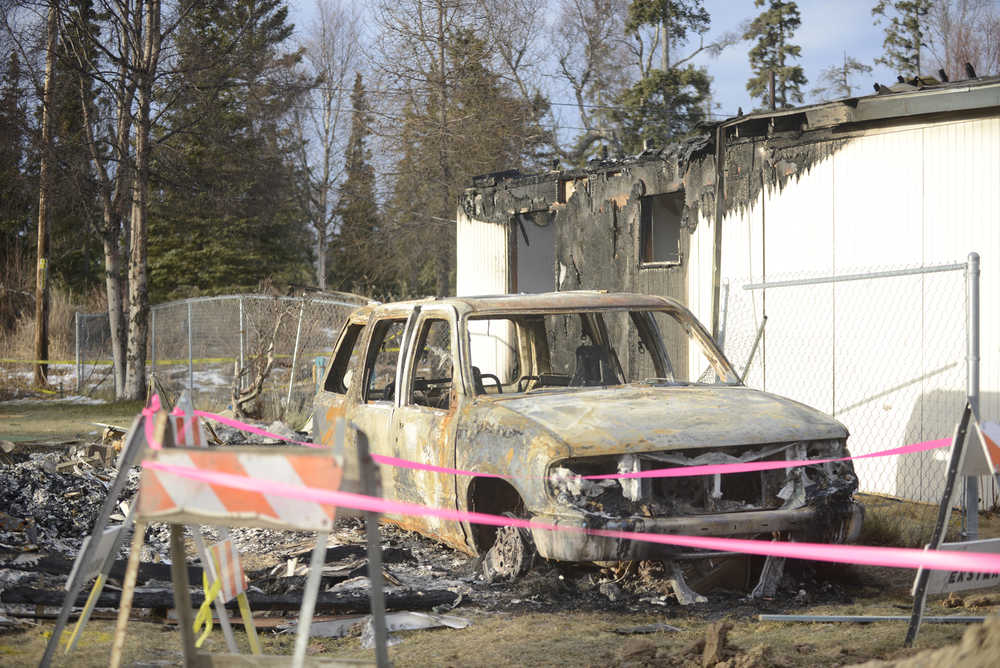After hearing how Kenai Peninsula agencies handled the aftermath of last Sunday’s magnitude-7.1 earthquake, Gov. Bill Walker concluded that their training and communication played a part in the lack of serious damage or injuries.
Walker was briefed Sunday by representatives of public safety departments, local utility companies and public officials from Kenai, Soldotna and the Kenai Peninsula Borough at the Kenai Chamber of Commerce and Visitor Center.
“You did all the right things because you had the training, you knew what to do, you knew who to contact,” Walker told the representatives.
The main areas of focus following the record-setting tremor were a cracked stretch of highway on Kalifornsky Beach Road in Kasilof and four destroyed homes on Lilac Lane in Kenai, where Enstar Natural Gas Co. President Jared Green said Enstar members were working to make the area safe up until Friday.
“(There were) two residents who were out of their homes all the way through the end of the week,” Green said.
Those residents were returned to their homes on Friday, he said. Several in attendance at Sunday’s meeting mentioned how quickly first responders handled the situation in the Lilac Lane area.
“Within four minutes of the 911 call, you had an officer on scene to verify that everyone was out of their house when the initial explosion occurred,” said Kenai Police Chief Gus Sandahl in his presentation.
At the same time, Sandahl said a captain with the Kenai Fire Department made the call to begin an evacuation of the area.
“The evacuation of Lilac (Lane) was occurring within the first six, seven minutes,” he said.
Enstar is still in the process of putting together a report of the situation, Green said.
“With any major damage to Enstar’s system, we go and we do a thorough review of the damage and the events that caused the damage,” Green said. “We’re in the process of doing that obviously in this instance, but those take a long time.”
The Kenai Fire Department has been working with Enstar to try to determine the cause of the explosion, said Kenai Fire Chief Jeff Tucker.
As far as Homer Electric Association was concerned, everything worked like it was supposed to, even as members experienced outages, said Director of Member Relations Joe Gallagher. About 5,000 meters out of the company’s approximately 33,000 meters felt the effects of the quake.
When the tremor hit, it “opened up” a substation at Quartz Creek in Cooper Landing, disconnecting it and cutting the peninsula off from the rest of the system, effectively making it an “island,” Gallagher said.
When that happens, the energy on the system gets blocked up, creating an imbalance and threatening to cause a blackout, he said.
“When Quartz Creek opened up, we had a lot more generation on our system than we had demand,” Gallagher said. “So what we had to do was basically ramp down what we were doing at Nikiski, and also ramp down what was going on at Bradley Lake. Our frequencies were really unstable.”
The Quartz Creek substation came back online around 4:30 a.m. the same day of the earthquake, Gallagher said.
The Bernice Lake substation in Nikiski also went offline because the quake caused the station’s transformer to move around, which Gallagher said activated low level indicators. It was back online and about 4,100 meters in Nikiski and North Kenai regained power around 5:30 a.m., Gallagher said. About 600 HEA members in the Kasilof area also lost power, but it was restored around 4:30 a.m. as well, he said.
Kenai City Council member Brian Gabriel addressed the group as Vice Mayor in place of Kenai Mayor Pat Porter and as a representative of the Alaska Department of Transportation. The damaged section of K-Beach Road was smoothed out and reopened to two-lane traffic by Tuesday evening, he said.
Gabriel emphasized that, while damage caused by this quake was relatively minor, the question of what would have happened if the tremor had been more severe should be in the back of people’s minds.
“I think it’s important to assess what worked, what didn’t work, and then think about that next level,” Gabriel said.
Following the meeting, several city and department officials accompanied Walker out to Lilac Lane to show him the damage four houses sustained after gas explosions caused them to burn to the ground following the quake.
Walker commended the area agencies and departments for their timely communication with each other. He said that in the wake of the quake, he has received calls and questions about the future of public safety funding.
Walker said he plans to submit an item in his supplemental budget that would help fund the Alaska Land Mobile Radio system, a cooperative that provides communications for state, local and federal first responders through an integrated wireless network, by $1.2 million.
“I do get a lot of inquiries of people… expressing concern about, will our cuts in budgets impact safety? And we’re going to do everything we can to make sure that they don’t,” Walker said.
Reach Megan Pacer at megan.pacer@peninsulaclarion.com.

